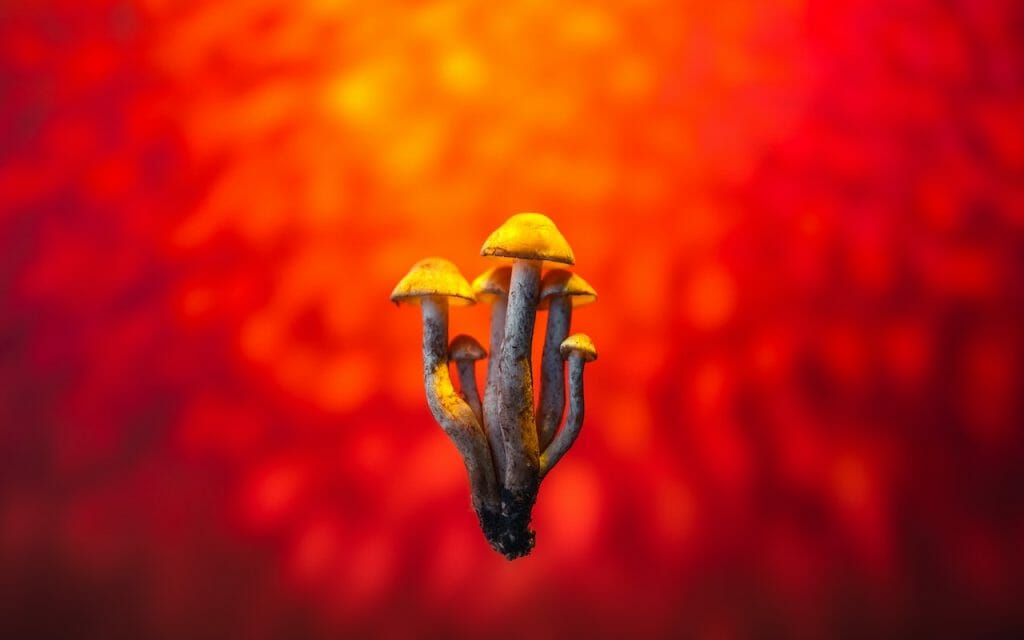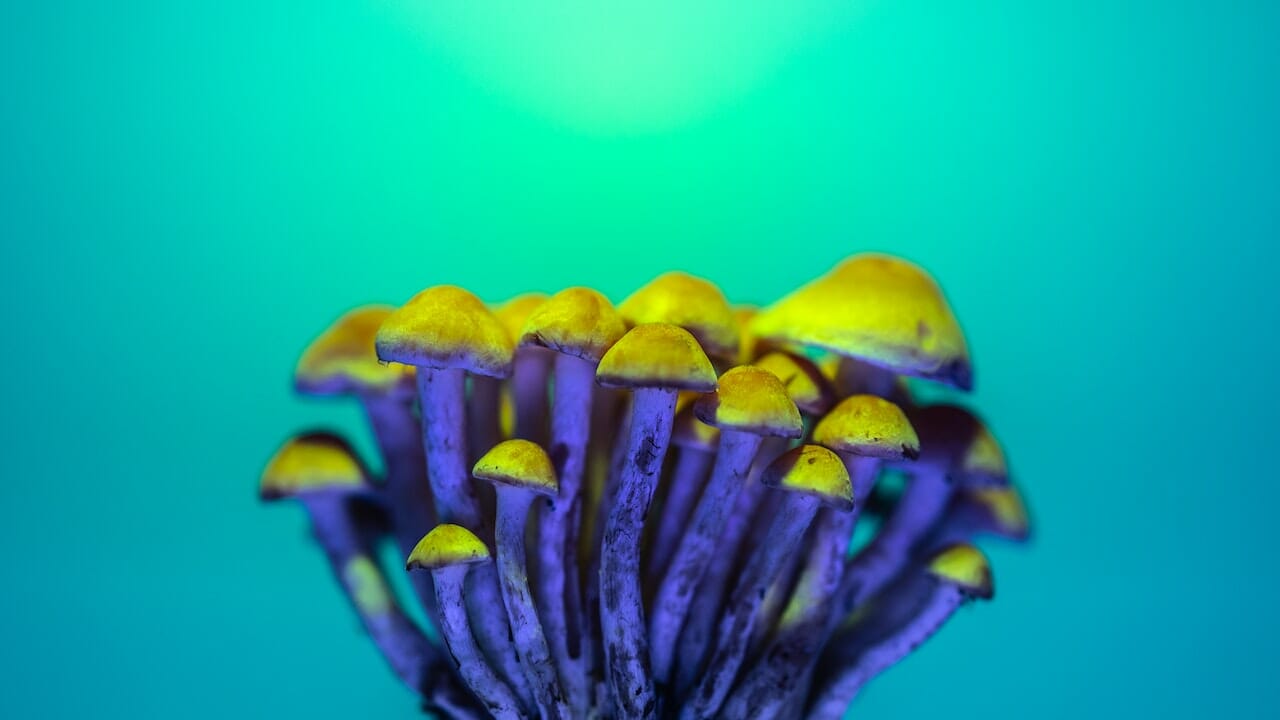LSD (lysergic acid diethylamide) is a powerful hallucinogen that has been extensively studied as a psychedelic substance. Initially renowned for recreational purposes, LSD has evolved into a psychoactive compound with potential mental health benefits. This change in outlook has fostered new opportunities for studying LSD’s impacts in a more palatable form, such as LSD edibles.
Key Takeaways:
- LSD is a powerful hallucinogen derived from the ergot fungus.
- LSD shares similarities with psilocybin and affects the 5-HT2A receptors.
- LSD is known to induce visual distortions, mood fluctuations, ego dissolution, and pseudo-hallucinations.

Exploring LSD
LSD is an exceptionally potent hallucinogen that can dramatically change a person’s perception of reality and profoundly distort the senses. LSD originates from “ergot,” a fungus found on rye and other grains.
At the molecular level, LSD is a complex chemical belonging to the ergoline family. It contains a bicyclic hexahydroindole group and a bicyclic quinoline group (lysergic acid). The name ‘Lysergic Acid Diethylamide’ is derived from the functional group attached to its core. LSD’s structure is akin to other ergoline alkaloids, like ergotamine, found in the ergot fungus Claviceps purpurea, and the neurotransmitter serotonin.
The Effect of LSD
Upon consumption, LSD seeps into the brain, triggering chemical responses that can persist for several hours. Short-term effects of LSD may include:
- Unforeseeable mood changes
- Distorted perception
- Feeling dizzy
- Reduced appetite
- Hindered motor skills
The Benefits What are the Benefits of LSD Use?
LSD offers a range of benefits that largely hinge on the amount consumed. Most scholarly investigations concentrate on the advantages associated with moderate consumption of this potent psychedelic. In the following section, we explore the positive outcomes tied to LSD use.
Neuronal Growth and Pain Management
Research conducted by Maastricht University indicates that a single microdose of LSD can generate pain-relief effects lasting at least five hours or more.
In the Cold Pressor Test, where participants immerse their hands in 3°C (37.4°F) water for as long as possible, those who consumed 20 mg of LSD kept their hands underwater for 20% longer than the control group. They also reported less pain and discomfort.
Furthermore, LSD can facilitate the development and expansion of the brain’s 86 billion neurons. Moderate LSD doses, ranging from 5 to 20 ug, increase the concentration of BDNF in the blood plasma. This is noteworthy considering mood disorders such as depression often stem from issues with neuroplasticity, and may be alleviated due to LSD’s beneficial impact on neuron health.
Improves Mental Health
Dr. Robin Carhart-Harris from Imperial College London introduced the entropic brain hypothesis. This idea implies mental health disorders originate from rigid thought patterns, perpetuated by an excessively active default mode network (DMN). Psychedelic substances like LSD have the capacity to interrupt the DMN, boost brain entropy, and promote the dismantling of negative neural pathways while fostering the creation of positive ones.
A study involving over 1,000 participants who microdosed LSD reported a decline in depression. A separate large-scale study demonstrated a decrease in negative feelings and harmful attitudes, while observing an increase in open-mindedness and cognitive function.
Effective Treatment for Addiction
A comprehensive review of randomized-controlled clinical trials using LSD in psychiatry concluded that it is particularly effective in addressing alcohol dependency. This conclusion is further reinforced by the positive results achieved by numerous patients treated for alcoholism by Humphrey Osmond and at the Spring Grove Hospital Centre during the 1950s and 1960s.
Relief from Anxiety and Depression at Life’s End
Dr. Peter Gasser discovered that LSD-assisted psychotherapy can help patients suffering from terminal cancer to reduce their anxiety about dying. It also appears to significantly improve their subjective quality of life. Currently, a Phase 2 trial is underway to explore the potential benefits of LSD therapy for depression.
Deciphering LSD Edibles: A Look at Their Composition and Manufacturing Process
LSD edibles are food or drink items infused with the hallucinogenic substance, LSD. These edibles can come in a variety of forms, including chocolates, candies, baked goods, and even unique items such as LSD mints.
The Contents
- LSD: This is the active ingredient that creates hallucinogenic effects. It is carefully measured and incorporated into the edible.
- Edible Base: The LSD is usually dissolved or infused into a consumable substance such as a gummy, candy, sugar cube, or other ingestible materials. These substances act as the delivery mechanism for the hallucinogenic compound.
- Flavouring and Ingredients: The specific edible product may contain flavourings, sweeteners, and other ingredients to enhance taste and texture. These may range from natural or synthetic flavours, colours, and sugars, and can vary widely.
Manufacturing Process:
- LSD Synthesis: The first step involves the chemical production of LSD. This process requires extensive knowledge of organic chemistry and the necessary chemicals, equipment, and a laboratory environment.
- Liquid Formulation: Once the LSD has been synthesized, it is usually transformed into a liquid form by being dissolved in a solvent. This liquid acts as a concentrated LSD solution.
- Infusion: The liquid LSD is then infused into an edible substance such as gummy candies, sugar cubes, or blotter paper. The infused substance absorbs the liquid, enabling the LSD to be consumed orally.
Experiencing the Psychedelic Impact of Psychoactive Compounds in LSD Edibles
LSD causes dramatic visual effects. Colours appear more vivid, objects may seem to have halos or rainbows around them, and shapes can change. Regardless of whether the eyes are open or closed, users may see
Vividly hued, quickly changing geometric designs are among the numerous visual distortions experienced. They are considered “pseudo-hallucinations” because while they are not real, users understand they are induced by the drug.
LSD serves as a pathway for modifying one’s self-perception and environment. This compound can trigger various mental states. Thoughts may appear clear and meaningful, or they may lack logical consistency. Other impacts may include alterations in the perception of time, distance, and self-image. The boundary between the self and the external world may appear blurred. Some users report experiencing sensory blending, such as seeing music or hearing colours.
Recommended LSD Products
There is a wide variety of LSD edibles available, but it’s essential to purchase from a trustworthy dispensary. You have to make sure that the edibles contain LSD and not other substances like PCP (embalming fluid), ecstasy, or ketamine.
Deadhead Chemist – LSD Infused Gummies
Deadhead Chemist offers LSD-infused edibles, each containing 100 micrograms (ug) of LSD, available in various flavours. Each package comes with a single gummy, which has demonstrated potential in assisting individuals with conditions like obsessive-compulsive disorder (OCD), post-traumatic stress disorder (PTSD), alcoholism, depression, and cluster headaches.
Deadhead Chemist – Mint Tea
Deadhead Chemist’s raspberry mint tea provides a tastier and more flavourful way to experience the effects of LSD. LSD and other psychedelics mimic the serotonin neurotransmitter and heighten the brain’s flow state.
Earthly Delights – Candy Flips
Candy flipping became popular during the late 1980s rave culture. Today, thrill-seekers and party-goers continue to enjoy the combination of these two remarkable substances. Users often report intense feelings of love and interconnectedness, paired with captivating visual effects such as colour enhancement, object morphing, and complex geometric patterns.
Final Thoughts
LSD has traditionally been linked to life-changing experiences. With a greater understanding of this substance, its usage has skyrocketed, especially with the introduction of LSD edibles. These delicious morsels have opened up a new exploration path for people.
Experience LSD safely and pleasurably through controlled dosages.
As the leading provider in Canada of high-grade online shrooms, Shroomyz Canada offers a broad variety of LSD-infused edibles and cannabis products. Explore our selection at your own pace, add the items you want to your basket, and sit back as we handle the delivery. We also offer an extensive range of psilocybin shrooms, edibles, drinks, and capsules for your ease. Make sure to check out our LSD delivery page for additional details!
Frequently Asked Questions
How does LSD differ from psilocybin?
ATTRIBUTES LSD PSILOCYBIN Source Semi-synthetic chemical compound Naturally occurring in fungi Available Forms Tabs, microdots, liquid, gummies, blotter paper Dried mushrooms, capsules, teas, chocolates Potency Highly potent, microgram doses (ug) Varies based on mushroom species and preparation Onset and Duration Quick onset (15-60 minutes), short duration (3-5 hours) Gradual onset (30-60 minutes), moderate duration (4-6 hours)
How can one avoid negative experiences with LSD?
- Choose Your Environment Wisely
- Prepare Your Mentality
- Start with a Small Dose
- Arrange for a Trip Supervisor
- Create a Tranquil Atmosphere
- Apply Deep Breathing and Grounding Methods
- Accept and Release
How long do the effects last?
The impacts of the acid will begin to show between 30-60 minutes after intake. Individuals with a heightened sensitivity to psychedelics may start to experience the effects In just a short 15-minute span, you’ll be able to discern if you’ve ingested LSD. About an hour into the experience, you’ll start to sense the effects, peaking around three hours in. During this peak, time can seem to stretch and hallucinations may occur.
Hold fast, it is not unusual to feel a disconnection from reality during this peak period. This phase lasts between 3 to 5 hours, after which the offset phase persists for another 3 to 5 hours.
How does LSD interact with the human body?
The primary interaction of LSD is with the brain’s serotonin system, where it binds to and stimulates the 5-HT2A receptor. This binding initiates a cascade of neurochemical and physiological reactions. Various factors can influence the effects of LSD, which can differ significantly.
Does LSD come in forms other than edibles?
Yes, LSD is available in various formats. The four primary types of LSD products include blotter paper, liquid solutions, tablets/microdots, and gelatin sheets.
Suggested Readings:
| ATTRIBUTES | LSD | PSILOCYBIN |
| Source | Semi-synthetic chemical compound | Naturally occurring in fungi |
| Available Forms | Tabs, microdots, liquid, gummies, blotter paper | Dried mushrooms, capsules, teas, chocolates |
| Potency | Highly potent, microgram doses (ug) | Varies based on mushroom species and preparation |
| Onset and Duration | Quick onset (15-60 minutes), short duration (3-5 hours) | Gradual onset (30-60 minutes), moderate duration (4-6 hours) |





